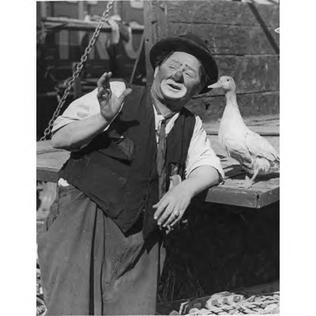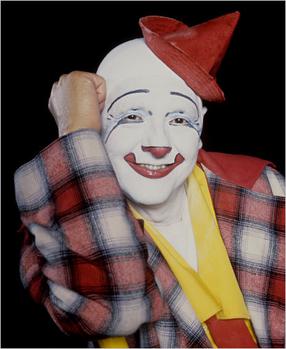Related Research Articles

Emmett Leo Kelly was an American circus performer, who created the clown character "Weary Willie", based on the hobos of the Great Depression in the 1930s.

A circus is a company of performers who put on diverse entertainment shows that may include clowns, acrobats, trained animals, trapeze acts, musicians, dancers, hoopers, tightrope walkers, jugglers, magicians, ventriloquists, and unicyclists as well as other object manipulation and stunt-oriented artists. The term circus also describes the field of performance, training and community which has followed various formats through its 250-year modern history. Although not the inventor of the medium, Newcastle-under-Lyme born Philip Astley is credited as the father of the modern circus.

The Ringling Bros. and Barnum & Bailey Circus, also known as the Ringling Bros. Circus, Ringling Bros., the Barnum & Bailey Circus, Barnum & Bailey, or simply Ringling, is an American traveling circus company billed as The Greatest Show on Earth. It and its predecessor have run shows from 1871, with a hiatus from 2017 to 2023. They operate as Ringling Bros. and Barnum & Bailey. The circus started in 1919 when the Barnum & Bailey's Greatest Show on Earth, a circus created by P. T. Barnum and James Anthony Bailey, was merged with the Ringling Bros. World's Greatest Shows. The Ringling brothers purchased Barnum & Bailey Ltd. in 1907 following Bailey's death in 1906, but ran the circuses separately until they were merged in 1919.
Ringling Bros. and Barnum & Bailey Clown College was an American circus school which trained around 1,400 clowns in the "Ringling style" from its founding in 1968 until its closure in 1997.

Circus clowns are a sub-genre of clowns. They typically perform at circuses and are meant to amuse, entertain and make guests laugh.

Lillian Leitzel was a German-born acrobat who specialized in performing on the Roman rings, for the Ringling Brothers and Barnum and Bailey Circus. The inaugural (posthumous) inductee to the International Circus Hall of Fame, Leitzel died in hospital two days after a fall during a live performance.

The Hagenbeck–Wallace Circus was a circus that traveled across America in the early part of the 20th century. At its peak, it was the second-largest circus in America next to Ringling Brothers and Barnum and Bailey Circus. It was based in Peru, Indiana.

Circus World was a theme park built north of Haines City, Florida in Polk County, on the south-east corner of the Interstate 4-US 27 interchange. It was originally a property of the Ringling Bros. and Barnum & Bailey Circus Combined Shows Inc., and was intended additionally to be the circus's winter headquarters as well as to have the Ringling Bros. and Barnum & Bailey Clown College and its museum located there.
The Flying Wallendas is a circus act and group of daredevil stunt performers who perform highwire acts without a safety net. They were first known as The Great Wallendas, but the current name was coined by the press in the 1940s and has stayed since.

Johann Ludwig Jacob, professionally known as Lou Jacobs, was a German-born American auguste clown who performed for Ringling Bros. and Barnum & Bailey Circus for more than 60 years. He was inducted into the International Clown Hall of Fame in 1989. He is credited with popularizing the clown car, which has been a staple of circus clown acts ever since. He is also often cited as the originator of the red rubber ball nose, which is used by many clowns today. He was the first living person to have his portrait appear on an American postage stamp.

Otto Griebling was a German-born circus clown who performed for many years with the Cole Brothers and Ringling Bros. and Barnum & Bailey Circuses. He was one of four clowns given the title Master Clown by Irvin Feld.
Bill Ballantine (1910–1999) was an American writer and illustrator of circus subjects, as well as a professional clown.
Hugo Zacchini, one of the Zacchini Brothers, was the first human cannonball to use a compressed-air cannon. His father Ildebrando Zacchini invented the compressed-air cannon used to propel humans in circus acts. He was known for being a daredevil and a painter.

Bello Nock, often known simply as Bello, is an American daredevil and circus performer. Nock has been listed in the Guinness Book of World Records for his highwire walk over a cruise ship. He has performed several stunts in New York City, including rappelling off of Madison Square Garden and hanging from a helicopter over the Statue of Liberty. He has been included in a Time magazine list of "America's Best Artists and Entertainers".

Edmondo Zacchini (1894–1981) and Hugo Zacchini (1898–1975) were circus entertainers. They were the sons of Ildebrando Zacchini (1868–1948) and came from a large Italian family residing primarily in Tampa, Florida. While not all human cannonballs, all of papa Zacchini's children were circus performers of one sort or another.

Glen Gordon "Frosty" Little was a circus clown who served with the Ringling Bros. and Barnum & Bailey Circus for over 20 years. He was one of only four clowns ever to have been given the title "Master Clown" by the Ringling organization.
Barnum's Kaleidoscape was an American circus staged by Feld Entertainment, the owners of Ringling Bros. and Barnum & Bailey Circus, at a start-up cost of $10 million. It ran for one season, 1999–2000. Inspired by both European traditions and the contemporary circus movement, it was the first Ringling show to be held under a tent since 1956 and also its first one-ring presentation in more than a century. The tent was carpeted with wood flooring and amenities to create an intimate setting with seating for 1,800 on cushioned seats and sofas and no one further than 50 feet from the circus ring. Besides traditional circus fare like popcorn upscale items such as cappuccino and veggie wraps were offered. The show consisted of 62 performers, 54 crew members, 8 horses and 27 geese, with 50 trucks involved in moving it from site to site.
The Flying Caceres was created by Miguel Caceres in 1982 for the 112th Edition of Ringling Bros. and Barnum & Bailey Circus. Both Miguel and his wife, Luz Caceres, were flying trapeze artists from Colombia, South America. They came to the United States on a contract for Ringling Bros. and Barnum & Bailey Circus in the 1970s. Miguel worked with Ringling Bros. and Barnum & Bailey Circus for many years before forming The Flying Caceres in 1982.
Peru, Indiana native Brian Miser, also known as The Human Fuse, is a self-taught human cannonball. Featured on the 14th season of America's Got Talent. and a Guinness World Record holder, Miser is an American circus performer. Most commonly recognised for his headlining act at Ringling Bros. Barnum & Bailey Circus, during his touring career. Miser has appeared nationally on Conan O'Brien, David Letterman (twice), Huffington Post and CBS radio over the course of his career thus far. His historic Las Vegas stunt closed down the famous strip and catapulted Miser into the spotlight across the United States.

Zachary "Skeeter" Reece is an American clown. He became a clown after serving in the Vietnam War.
References
- 1 2 3 Lipton, James (2007). Inside Inside. Penguin. ISBN 978-0-525-95035-6 . Retrieved 13 September 2021.
- ↑ "The Angel and the Royal Zanettos". urban75. 4 September 2012. Retrieved 6 July 2024.